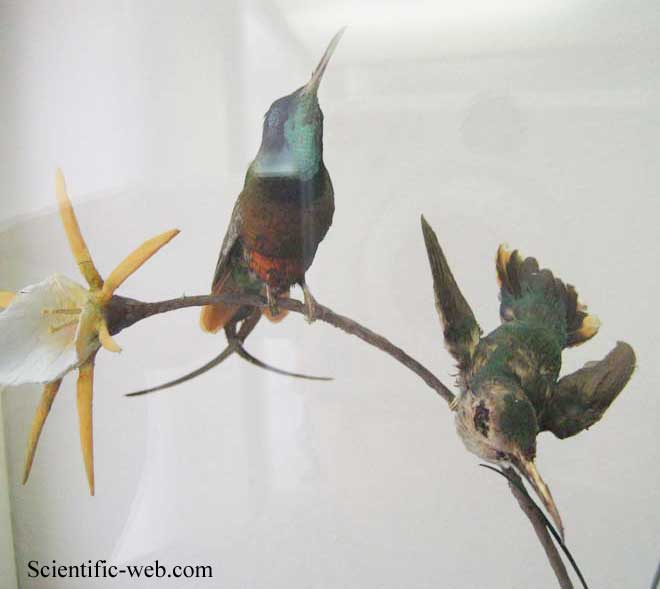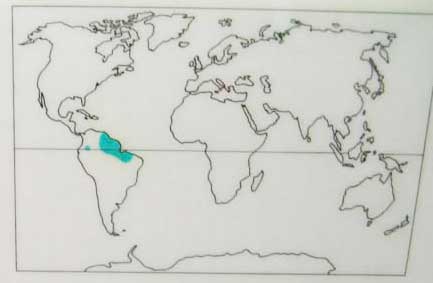
Topaza pella, Photo: Michael Lahanas
Superregnum: Eukaryota
Cladus: Unikonta
Cladus: Opisthokonta
Cladus: Holozoa
Regnum: Animalia
Subregnum: Eumetazoa
Cladus: Bilateria
Cladus: Nephrozoa
Superphylum: Deuterostomia
Phylum: Chordata
Subphylum: Vertebrata
Infraphylum: Gnathostomata
Megaclassis: Osteichthyes
Cladus: Sarcopterygii
Cladus: Rhipidistia
Cladus: Tetrapodomorpha
Cladus: Eotetrapodiformes
Cladus: Elpistostegalia
Superclassis: Tetrapoda
Cladus: Reptiliomorpha
Cladus: Amniota
Classis: Reptilia
Cladus: Eureptilia
Cladus: Romeriida
Subclassis: Diapsida
Cladus: Sauria
Infraclassis: Archosauromorpha
Cladus: Crurotarsi
Divisio: Archosauria
Cladus: Avemetatarsalia
Cladus: Ornithodira
Subtaxon: Dinosauromorpha
Cladus: Dinosauriformes
Cladus: Dracohors
Cladus: Dinosauria
Ordo: Saurischia
Cladus: Eusaurischia
Subordo: Theropoda
Cladus: Neotheropoda
Cladus: Averostra
Cladus: Tetanurae
Cladus: Avetheropoda
Cladus: Coelurosauria
Cladus: Tyrannoraptora
Cladus: Maniraptoromorpha
Cladus: Maniraptoriformes
Cladus: Maniraptora
Cladus: Pennaraptora
Cladus: Paraves
Cladus: Eumaniraptora
Cladus: Avialae
Infraclassis: Aves
Cladus: Euavialae
Cladus: Avebrevicauda
Cladus: Pygostylia
Cladus: Ornithothoraces
Cladus: Ornithuromorpha
Cladus: Carinatae
Parvclassis: Neornithes
Cohors: Neognathae
Cladus: Neoaves
Superordo: Caprimulgimorphae
Ordo: Apodiformes
Familia: Trochilidae
Subfamilia: Phaethornithinae
Genus: Topaza
Species: Topaza pella
Name
Topaza pella (Linnaeus, 1758)
Original combination: Trochilus pella

References
Linnaeus, C. 1758. Systema Naturae per regna tria naturae, secundum classes, ordines, genera, species, cum characteribus, differentiis, synonymis, locis. Editio Decima, Reformata. Tomus I. Holmiæ (Stockholm): impensis direct. Laurentii Salvii. 824 pp. DOI: 10.5962/bhl.title.542 BHL p. 119 BHL Reference page.
Vernacular names
Deutsch: Rotnacken-Topaskolibri
English: Crimson Topaz
español: Topacio candela colicanelo, Colibrí Topacio
euskara: Topaza pella
suomi: Punatopaasikolibri
français: Colibri topaze
magyar: Topázkolibri
polski: Topazik szkarłatny
پنجابی: رتہ پکھراج
português: Beija-flor-brilho-de-fogo
svenska: Karmosintopas
Türkçe: Kral sinek kuşu
The crimson topaz (Topaza pella) is a species of hummingbird in the family Trochilidae. It is found in Brazil, French Guiana, Guyana, Suriname, and Venezuela.[3][4]
Taxonomy and systematics
The crimson topaz was formally described by the Swedish naturalist Carl Linnaeus in 1758 in the tenth edition of his Systema Naturae under the binomial name Trochilus pella. [5] Linnaeus based his description on the "Long-tail'd red huming-bird" that had been described and illustrated by the English naturalist George Edwards in 1743 from a specimen owned by Charles Lennox, the Duke of Richmond. The specimen had been collected in Suriname.[6] The specific epithet is from the Latin pellus meaning "dark-colored".[7] The crimson topaz is now placed in the genus Topaza that was introduced by George Robert Gray in 1840 with the crimson topaz as the type species.[8][3]
Three subspecies are recognised:[3]
T. p. pella Linnaeus (1758)
T. p. smaragdulus Bosc (1792)
T. p. microrhyncha Butler, AL (1926)
The crimson topaz has been treated as conspecific with the fiery topaz (T. pyra) but currently (2021) the two are considered to form a superspecies.[9][10]
Museum specimen
Description
The male crimson topaz is 21 to 23 cm (8.3 to 9.1 in) long including the 5 cm (2.0 in) bill and 8.6 to 12 cm (3.4 to 4.7 in) tail, and weighs 11 to 18 g (0.39 to 0.63 oz). Females are 13 to 14 cm (5.1 to 5.5 in) long and weigh 9 to 12.5 g (0.32 to 0.44 oz). It may be the second largest species of hummingbird after the giant hummingbird, rivaled only by its cousin, the fiery topaz.[10][11]
Male and female crimson topaz have different plumages. Both have a straight to slightly decurved bill. The male's head, face, and the sides of the neck are velvety black. Its back is iridescent crimson to gold on the uppertail coverts. The central tail feathers are bronzy green and the outer ones chestnut; two of the latter are elongated and crossed. The throat is golden green surrounded by a black band and the underparts bright red. The wings are brown. The female's head and back are dark green and its underparts a lighter green with golden green inclusions; the throat is green with crimson inclusions. The central tail feathers are bronzy, the middle pair violet, and the outer pair chestnut, and none are elongated like the male's.[10]
Distribution and habitat
The subspecies of crimson topaz are distributed thus:[3][10]
T. p. pella, eastern Venezuela through Guyana and Suriname into northern and western Brazil as far south as Rondônia
T. p. smaragdulus, French Guiana and northeastern Brazil to between the Tapajós and Tocantins Rivers
T. p. microrhyncha, Brazil's northeastern Pará state east of the Tocantins and Marajó Island at the mouth of the Amazon
The species mainly inhabits inland rainforest in lowlands and foothills at elevations up to 500 m (1,600 ft). It frequents granite outcrops and also gallery forest along small waterways.[10]
Behavior
Movement
The crimson topaz is mostly sedentary during the breeding season but at other times appears to roam elsewhere seeking flowering plants.[10]
Feeding
Male crimson topaz defend feeding territories. The species feeds on nectar of flowering trees, mainly in the canopy of the forest, and also the flowers of vines and epiphytes. It has been observed feeding in flowering shrubs near the ground in Suriname. It also captures small insects in the air, both above the canopy and low along streams.[10]
Breeding
The crimson topaz's breeding season varies across its range; it has two seasons in the Guianas. Males make display flights that show the white feathers on their legs. The female builds a cup nest of Bombax seed fibers and spider web, often on vertical branches or in vines, and often over water. The clutch size is two eggs.[10]
Dickcissel male perched on a metal pole singing, with neck stretched and beak open.
Songs and calls
Listen to crimson topaz on xeno-canto
Vocalization
The crimson topaz's song is an "irregular series of chattering 'chip' notes given almost continually (other than breaks to feed) throughout the day." It often sings from a perch in the canopy and may make short flights out and back to the same perch between songs.[10]
Status
The IUCN has assessed the crimson topaz as being of Least Concern, though its population has not been enumerated and is believed to be decreasing.[1] It is considered rare to locally common, but may be undercounted because of its treetop habits. It occurs in several protected areas and continues to be discovered in "gaps" in its range.[10]
References
BirdLife International (2016). "Crimson Topaz Topaza pella". IUCN Red List of Threatened Species. 2016. Retrieved 12 November 2021.
"Appendices | CITES". cites.org. Retrieved 2022-01-14.
Gill, F.; Donsker, D.; Rasmussen, P. (July 2021). "IOC World Bird List (v 11.2)". Retrieved July 14, 2021.
Remsen, J. V., Jr., J. I. Areta, E. Bonaccorso, S. Claramunt, A. Jaramillo, D. F. Lane, J. F. Pacheco, M. B. Robbins, F. G. Stiles, and K. J. Zimmer. Version 24 August 2021. Species Lists of Birds for South American Countries and Territories. https://www.museum.lsu.edu/~Remsen/SACCCountryLists.htm retrieved August 24, 2021
Linnaeus, Carl (1758). Systema Naturae per regna tria naturae, secundum classes, ordines, genera, species, cum characteribus, differentiis, synonymis, locis (in Latin). Vol. 1 (10th ed.). Holmiae (Stockholm): Laurentii Salvii. p. 119.
Edwards, George (1743). A Natural History of Uncommon Birds. Vol. Part 1. London: Printed for the author at the College of Physicians. p. 32, Plate 32.
Jobling, James A. (2010). The Helm Dictionary of Scientific Bird Names. London: Christopher Helm. p. 295. ISBN 978-1-4081-2501-4.
Gray, George Robert (1840). A List of the Genera of Birds : with an Indication of the Typical Species of Each Genus. London: R. and J.E. Taylor. p. 13.
Remsen, J. V., Jr., J. I. Areta, E. Bonaccorso, S. Claramunt, A. Jaramillo, D. F. Lane, J. F. Pacheco, M. B. Robbins, F. G. Stiles, and K. J. Zimmer. Version 24 August 2021. A classification of the bird species of South America. American Ornithological Society. https://www.museum.lsu.edu/~Remsen/SACCBaseline.htm retrieved August 24, 2021
Schuchmann, K.L., G. M. Kirwan, and P. F. D. Boesman (2020). Crimson Topaz (Topaza pella), version 1.0. In Birds of the World (J. del Hoyo, A. Elliott, J. Sargatal, D. A. Christie, and E. de Juana, Editors). Cornell Lab of Ornithology, Ithaca, NY, USA. https://doi.org/10.2173/bow.critop1.01 retrieved November 12, 2021
Dunning, John B. Jr., ed. (2008). CRC Handbook of Avian Body Masses (2nd ed.). CRC Press. ISBN 978-1-4200-6444-5.
Additional reading
Arthur Lennox Butler: Mr. A. L. Butler exhibited some examples of Topaza pella which he had recently received from the neighbourhood of Pará. In: Bulletin of the British Ornithologists' Club. Bd. 46, 1926, S. 56–57 (online [abgerufen am 19. Juni 2014]).
Da-Shih Hu, Leo Joseph, David Agro: Distribution, Variation, and Taxonomy of Topaza Hummingbirds (Aves: Trochilidae). In: Ornitologia Neotropical. Bd. 11, Nr. 2, 2000, S. 123–142
Harry Church Oberholser: Catalogue of a collection of hummingbirds from Ecuador and Colombia. In: Proceedings of the United States National Museum. Bd. 24, 1902, S. 309–342
Louis Augustin Guillaume Bosc: Description d'une nouvelle espèce de Grimpereau. In: Journal d'histoire naturelle. Bd. 1, 1792, S. 385–386, Tafel 20, Abbildung 5
Retrieved from "http://en.wikipedia.org/"
All text is available under the terms of the GNU Free Documentation License

